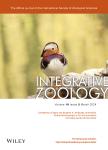Anuran interorbital distance variation:the role of ecological and behavioral factors
作者机构:Key Laboratory of Southwest China Wildlife Resources Conservation(Ministry of Education)China West Normal UniversityNanchongChina Key Laboratory of Artificial Propagation and Utilization in Anurans of Nanchong CityChina West Normal UniversityNanchongChina Institute of Eco-adaptation in Amphibians and ReptilesChina West Normal UniversityNanchongChina
出 版 物:《Integrative Zoology》 (整合动物学(英文版))
年 卷 期:2022年第17卷第5期
页 面:777-786页
核心收录:
学科分类:0710[理学-生物学] 071010[理学-生物化学与分子生物学] 081704[工学-应用化学] 07[理学] 08[工学] 0817[工学-化学工程与技术]
基 金:support was provided by the National Natural Sciences Foundation of China(31772451 31970393)
主 题:anurans behavioral factors body size hypoallometrical relationship interorbital distance
摘 要:Eye position varies significantly among taxonomic levels,and this variation is often shaped by ecological and behavioral *** position is often positively associated with interorbital distance where species with broad visualfields possess a large distance between the left and right *** pressures underlying the evolution of the eye position are especially studied in birds and ***,selective pressures underlying the evo-lution of anuran eye position which can be indicated by interorbital distance keep ***,we investigated the effects of ecological(*** type,light availability)and behavioral factors(*** pattern,foraging mobility,and defensive strategy)on variations in interorbital distance among 260 anuran species in *** results showed that variations of the interorbital distance can be significantly predicted by the activity ***-turnal species had larger interorbital distance than both nocturnal and diurnal *** also found that foraging mobility and defensive strategy markedly affected variation of interorbital *** having slower foraging mobility and possessing poison glands had larger interorbital distance than species having faster foraging mobility and possessing non-position *** availability tended to be associated with variation of interorbital distance,indicating that species living in weak light tended to possess larger interorbital ***,variations of the interorbital space were not associated with habitat type in ***findings suggest that anuran behaviors play key roles in shaping visualfields and eye position,thus affecting the evolution of interorbital distance.



